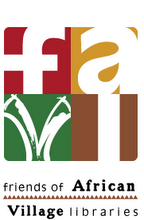Here's my input- what I think is the simplest way to catalog and organize books:
1) Start an "accession book" (a good hardbound notebook)
2) Each page is divided into 5 columns
a- Unique number for each book (doesn't matter if is a second, 3rd, 4th copy- every book has to have a unique number... absolutely necessary for doing inventory.
b- Book title
c- Book author
d-Dewey number if whoever trained the librarian insisted on this and you don't want to contradict the previous training (otherwise simple book category)
e- remarks (i.e. destroyed, noted lost in inventory of March 2009, patron lost 5/08, sent to Dodoma for binding)... remarks are best written in pencil so that can be erased (if book found!)
Best categorization system is to use color tape- cut small piece tape (and over with clear tape) on edge of binding (so facing outwards from shelf can see color. Dewey number can be written on tape for further classification).
The most important thing is for every book to have a number- and the numbers should start in order, from 0001 through 3987.... that way, when doing an inventory, the following procedure can be followed:
-obtain from FAVL copies of "list of numbers"- a set of pages that consist of all the numbers, in order, from 0001 to 3987 (if that is how many books are in the library)
-one person starnds at the shelves, at one end of the library, and reads aloud the book number, working through the shelves
-a second persons sits at a desk, and checks off (cross out) the numbers as they are called
-all numbers that remain unchecked must then fall into one of three categories
1-book checked out (and these may be subdivided into those late)
2-book in "storage" (where damaged books go)
3-book lost/stolen
For a 3000 book library, the inventory might take a full day, and librarian should get a compensation for self plus assistant.
Kate Parry adds....
In East Africa (or at least in Uganda, and I think it will work the same in Tanzania) the least expensive way to buy books is directly from the publishers. Therefore it's very useful to have a record of the publisher of each book. At Kitengesa we keep our records on a database, so we can easily generate a list of our books arranged by publisher, which makes it easy to check what titles we already have when buying new ones. The information is really only important for local purchases, but that's where most books in the library should come from in any case, especially in the early stages.
About categories: we began with a list of about 6 categories, which has now expanded to about 30 (most of the expansion, though, has been in response to foreign donations, which really mess things up!). We put a label on each book with the accession number and the category name and arrange the books on the shelves by category, and within that by number; we label the shelves by category too. This arrangement makes the inventory a little more difficult, but it means that library users can more easily find the kind of book they want. I think is the most important factor, unless you want the librarians always to find the books for them. I was discussing the issue of classification with one of the librarians at our UgCLA workshop yesterday, and we agreed that the Dewey decimal system doesn't really suit our purposes because it is so Euro/Neo-Eurocentric. For example, Kiswahili is lumped in with "other languages", in contrast to, say, German, which has a number of its own. What we need to do is to have a workshop developing an Afrocentric system and send the results to the publishers of Dewey. That, however, will have to be several years down the road!
Wednesday, July 30, 2008
Subscribe to:
Post Comments (Atom)

No comments:
Post a Comment